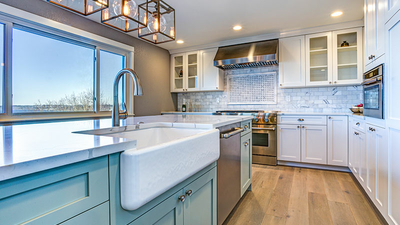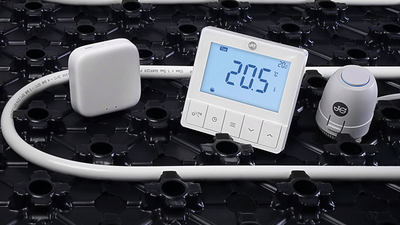The three design trends influencing plumbing and heating in 2024

Undertaking home improvement works is a proven way for homeowners to put their individual stamp on a property. While these works will ultimately be looking to improve aesthetics, functionality and comfort, many will need to be supported by behind-the-scenes systems – and plumbing and heating can play a key role in bringing design trends to life.
Kitchens and bathrooms are spaces that homeowners might be looking to improve, with kitchens in particular creating more welcoming spaces for entertaining. Of course, these rooms are naturally more plumbing-intensive areas of a home, so improvements may require expert support.
By putting an emphasis on quality, installers can be confident that systems will be able to stand up to everyday use, without compromising on aesthetics. The right selections can even help to elevate efficiency for homeowners, enhancing long-term performance and sustainability.
1. Sleek design
Contemporary styles are leading the way in bathroom and kitchen design trends, with minimalist aesthetics being complemented by everyday functionality to create spaces that work for everybody in the home.
Where showers are concerned, interior design trends are demonstrating a shift away from traditional glass screens in favour of built-in showers. To achieve a desirable and timeless aesthetic, this design trend in plumbing will require installers to carry out intricate installations, keeping pipework out of sight wherever possible. In practice, this could mean navigating tight spaces, while ensuring strong connections that deliver reliability for the long-term.
The use of JG Speedfit pipes, fittings and tap connectors, featuring push-fit technology, will support this design trend in plumbing. Making tool-free connections possible, installers will be able to create strong and efficient systems that support sleek designs, operating effectively for years to come with components that stand the test of time.
Once the integral parts of the system are installed, homeowners can bring their spaces to life. Here, splashes of colour will help to bring spaces to life, while intricate storage solutions will support the popular minimalistic, uncluttered look.

2. Out of sight, out of mind
Where heating is concerned, there is a growing trend to keep it hidden from view as much as possible. The challenge for installers lies in creating systems that underpin comfort, without encroaching on spaces that need to remain functional for modern families.
While one of the emerging trends here is vertical radiators which can be incorporated into rooms as a design feature, another of the answers to this conundrum is underfloor heating (UFH). Underfloor heating has been increasing in popularity over recent years, with even more growth on the horizon in retrofit projects. By transforming the floor space into a room’s heat source, UFH effectively distributes heat across a space – minimising the cold spots often associated with radiators. Similarly, UFH operates at significantly lower temperatures than radiators (between 45° to 55°C instead of 65°C to 80°C), leading to greater sustainability and potentially lower operating costs.
From a design point of view for homeowners, adopting UFH over traditional radiator systems unlocks greater design freedom in their home. These design trends in plumbing require pipework to be hidden beneath the floor and radiators removed from walls, giving homeowners greater wall space, allowing them to re-work their interior spaces and layouts. Together, the more consistent warmth of UFH combined with more practical spaces, homeowners will be able to create comfortable spaces that truly work for them and their families.
With heating hidden away – or made into a design feature – installers can support customers to achieve the modern interior spaces that set their homes apart.
3. Performance on demand
Whether it’s built-in showers with rainfall heads, kitchen taps providing instant hot water, or hidden heating keeping homes comfortable, design trends in plumbing and heating requires performance on demand. To make that possible, installers will need to utilise components that maximise the potential of every installation.
The installation of pressure reducing valves (PRVs) will help to stabilise the flow rate within a property, ensuring an adequate supply for every appliance. For the best results, a PRV should be installed at the point where water first enters a property, providing complete control over water usage. Additionally, installers will need to consider regulating the flow to particular appliances to allow them to operate as expected. Flow regulating valves – including the Floreg from Reliance Valves – make this possible, optimising performance while managing water consumption across the home.
While valves work in the background to maintain performance and efficiency, smart controls can be installed to keep users in complete control of their usage. Smart thermostats, for example, can be seamlessly installed to regulate the temperature of home heating systems – including underfloor heating.

4. Maximising efficiency
The performance of plumbing and heating systems has always been a key factor for installers and their customers, so when carrying out upgrades to kitchens, bathrooms and heating systems, installers have the opportunity to prioritise efficiency. In practice, implementing solutions that underpin the efficient performance of systems is key to installing sustainable systems.
Water conservation is essential in efficient and sustainable plumbing and heating systems – and minimising the potential for leaks is key to this. This improved efficiency can reduce running costs for homeowners and minimise the potential for water-related damage in the future. To achieve this in new systems, professionals can look to reduce the number of connections need along the pipework.
Firstly, designing and planning systems to minimise the number of connections is a strong first step to maximising efficiency. Sometimes connections can fail due to poor installation or as a result of wear and tear, or through broken seals and system blockages. Whatever the cause, reducing connections is key to strengthening systems. Using solutions like JG Layflat Pipe can support installers in creating strong systems that prioritise efficiency and minimise connections. In practice, the polybutylene coil pipe facilitates long pipe runs, as well as providing the flexibility to navigate corners and tight spaces. Where connections are still required, installers can utilise JG Speedfit Twist & Lock fittings and Superseal Inserts to create a strong and reliable multi-seal connection between pipe runs.
Using these solutions when undertaking retrofit kitchen and bathroom installations can remove some of the complexity for installers, making jobs quicker and easier, whilst not compromising on security and reliability once the job is complete. For customers, the benefits are clear to see, with the delivery of a new design that complements their aesthetic ambitions, all backed up by high quality, efficient and reliable plumbing.
Marrying reliability and aesthetics
By taking a smart approach to design trends in plumbing and heating, installers can support their customers in achieving their interior design ambitions while improving comfort, sustainability and system performance. Whether it’s bathrooms and kitchens that prioritise minimalism and functionality, or heating systems that put efficiency first, installers can adopt innovative technologies to fulfil the latest design trends.
To consistently deliver for customers, installers can leverage the potential of systems from leading manufacturers. In practice, these technologies can underpin the efficient and reliable performance of plumbing and heating systems, while adapting to new trends and future-proofing homes for the long-term.
Our family of brands
Explore our range of solutions sharing the same DNA of trusted, time-saving innovation and precision-engineered reliability.
